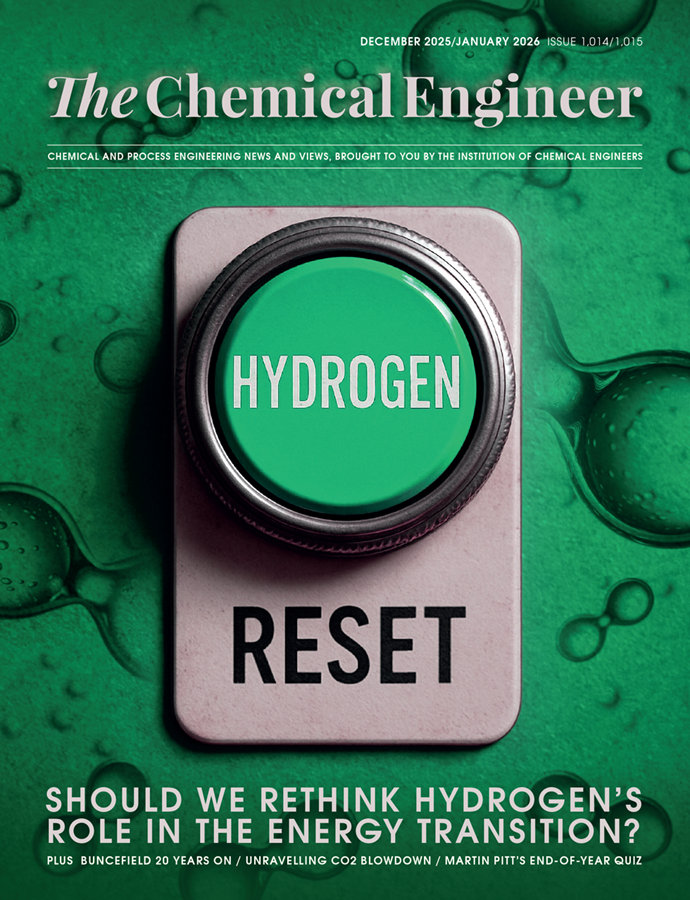Producing Hydrogen While Storing CO2 in the Oceans
Mike Kelland and Greg Rau talk to Amanda Doyle about their clean-tech goals
REMOVING excess CO2 from the air, producing negative emissions hydrogen, and reversing ocean acidification are the three main goals of clean technology company Planetary Hydrogen. I spoke to founders CEO Mike Kelland and CTO Greg Rau about their plans to use their
electrochemistry process to produce hydrogen while also capturing CO2 from the air which can then be safely stored in the oceans as a carbonate.
The Earth has a natural cycle to regulate CO2 on geological timescales. CO2 is released from sources such as volcanoes, and then eventually is stored in sediments, the ocean, or living organisms. However, humans burning fossil fuels has released excessive amounts of CO2 into the atmosphere, which has disturbed the carbon cycle and led to a climate crisis.
Rau, a geochemist and senior research scientist, has been studying the carbon cycle for years, where he gained an appreciation for the role that geochemistry plays in managing atmospheric CO2 on a geological timescale. These studies developed into an idea of essentially accelerating the process to remove CO2 from the atmosphere faster using electrochemistry. Kelland, a serial entrepreneur who was looking for a yet untapped climate solution with strong commercial potential, approached Rau in 2019 after reading his publications1. Rau and Kelland then formed Planetary Hydrogen, and with a small team of scientists and engineers, they are aiming to tackle both the climate and biodiversity crisis with one process.

Splitting water and salts
The core of Planetary Hydrogen’s process is splitting water and salt and is similar to the chlor alkali process which is commonly used in industry. The water and salt are split into hydrogen, oxygen, an acid, and a base. Typically in electrolysis, the acid and base recombine in the cell and there’s no net change in pH. In the Planetary Hydrogen process, they are kept separate so that the base can be used to capture CO2. The base is hydroxide, with which CO2 is very reactive, forming carbonates and bicarbonates. Planetary Hydrogen’s innovation involves improving the efficiency of the electrochemical process and safely using natural ocean chemistry as a way of storing CO2.
The process uses deionised water, although Rau described using seawater as the “holy grail”, as it would make the process cheaper and easier to scale. However, there are challenges associated with using seawater.
“In a perfect world we would use seawater because obviously it’s the most abundant electrolyte on the planet and we could use it straight out of the ocean. The problem with seawater and sodium chloride electrolytes in general is that you typically make chlorine rather than oxygen. You actually split the salt, and that sodium chloride comes off as chlorine. While there could be offtakers for this, it is obviously a dangerous gas, it has to be very carefully handled and used. For the time being we’re going to avoid that issue by using an alternative salt. We’re going to use a non-chloride salt in our process such as sodium sulfate or some other salt.”
Rau said that if the process moves to global scales and salt supplies become an issue, then they will assess the sodium chloride problem, as some research suggests that there are methods of avoiding chlorine generation.
He also added that the company is exploring non-marine based use of the technology as a way to potentially expand global capacity. “Right now our focus is on the ocean because it has such large potential, but obviously if we were to just exclusively do that we would just restrict ourselves to the coast and there’s obviously offtakers of our products inland. We are exploring ways that would allow us to do this process without necessarily involving the ocean.”
Removing CO2 from the air
A typical carbon capture system – whether it’s from flue gas or direct air capture – will require a sorbent such as an amine to capture the CO2. This then has to be heated to extract the pure CO2, and regenerate the sorbent. Following this, the CO2 needs to be pressurised into a supercritical fluid so that it can be sequestered underground. These processes therefore require a lot of energy. “In our system we avoid those steps because we never actually take the CO2 out of our sorbent, it remains in that bicarbonate,” said Kelland. “Then it can be added to the ocean and to the already massive repository of carbon within the ocean’s chemistry.”
The process could use CO2 from flue gas or direct air capture, but the aim is to directly capture carbon from the air by using the ocean’s surface as an air contactor. By introducing a dilute form of alkalinity to the surface ocean, Planetary Hydrogen’s process converts excess CO2 already dissolved in the ocean into stable bicarbonate, enhancing the ocean’s natural ability to act as a carbon sink while reducing local ocean acidification. Since the ocean effectively captures and stores the carbon, the process promises to be more energy efficient than other CO2 removal technologies.
Producing hydrogen, oxygen, and acid
As well as storing CO2, the process creates several useful products, such as green hydrogen. “In our case it’s ‘super green’ because if we power the technology by renewable energy, we not only have a zero emissions hydrogen, but because we’re actively consuming CO2 we actually have a negative emissions hydrogen,” said Rau.
Hydrogen is a valuable commodity, and Kelland explained some of the possibilities for the hydrogen produced by the company, including hydrogen derivatives like ammonia or methanol for shipping. “We’re looking at zero emissions ships here on the east coast of Canada, we’re talking to the local gas utility Heritage Gas about inserting hydrogen into their gas grid as a blend with natural gas, we’ve had conversations with the power utility here about using hydrogen for seasonal storage of power, and we’ve spoken to refiners around the world about using our hydrogen in order to produce low or even negative carbon intensity fuel.”
As the acid and base are not recombined in this process, the acid becomes a byproduct which also has potentially useful industrial applications with the added bonus of being produced with negative emissions. Rau explained that even if there wasn’t commercial interest in the acid, it could be neutralised using alkaline minerals to form benign mineral salts. The oxygen produced could also have industrial applications, making it another commercially-viable product.

Potential environmental concerns
One environmental concern with Planetary Hydrogen’s process is the potential need to mine for mineral salts. However, there is an alternative that would avoid the need for mining, as Rau explained. “Another angle here would be to look for waste streams that already have these salts in them and as it turns out sodium sulfate is a not uncommon waste stream in mining and other processes so one thing we’re looking at is ways of piggybacking onto processes that naturally generate sodium sulfate already and that would provide us with a ready source of our electrolyte.”
Another concern is tinkering with ocean chemistry and the ecosystem by adding more CO2 in the form of carbonates and bicarbonates. The oceans already contain around 38,000bn t of CO2, and according to the IPCC2, the oceans have absorbed around 500bn t out of 1,300bn t of anthropogenic CO2 emissions in the last 200 years. There are no limits on the amount of CO2 that could be stored in the oceans, but the time taken for this to happen would need to be greatly accelerated. Weathering and absorption of CO2 by the oceans would eventually reduce current levels of atmospheric CO2 to pre-industrial levels, but this will take hundreds of thousands of years.
“Ultimately our goal as a company is that our technology is taking about 1bn t of CO2 out of the air every year by 2035”
CO2 is naturally added to the oceans as part of the carbon cycle in two main ways. The slow way is through rock weathering. The fast way is through direct dissolution out of the atmosphere. CO2 reacts quickly with water to form carbonic acid (H2CO3) which then dissociates to produce bicarbonate ions (HCO3-) and a hydrogen ion (H+). This further dissociates to form carbonate ions (CO32-) and H+. This naturally makes the oceans slightly alkaline, however excessive absorption of CO2 from the atmosphere creates an excess of H+ which lowers the pH. This is partially responsible for increasing ocean acidification. Another factor causing ocean acidification is the reduction in the concentration of carbonate ions which results in fewer available to organisms that need them. Ocean acidification has a negative impact on many ecosystems, but coral reefs are particularly vulnerable as it reduces calcification – the process by which corals build their calcium carbonate skeletal structures.
However, by adding CO2 to the oceans as carbonate or bicarbonate without the excess H+, the ocean alkalinity can be increased to pre-industrial levels. This process mirrors the slower rock weathering that happens in nature. Studies have shown that this can work and be beneficial for ocean life. For example, a 2016 Nature3 study on the Great Barrier Reef found that enriching the alkalinity of seawater by adding sodium hydroxide improved the calcification of a coral reef community.
Planetary Hydrogen is currently working with the Department of Oceanography at Dalhousie University, Nova Scotia, to evaluate the benefits and impacts of alkalisation of the ocean. “We realise that there has been very little, if any, work done on alkalisation of the ocean,” said Rau. “There’s a few examples which actually turned out to be beneficial to the ocean, but certainly not enough R&D has been done and we do need to understand the benefits and impacts of adding alkalinity at whatever level. That is a big part of what we are going to be researching.”
Kelland added: “We’re embarking on this research now with Dalhousie, Canada’s Department of Fisheries and Oceans, with the ClimateWorks Foundation, with the Thistledown Foundation and a number of other partners to demonstrate that not only is this viable and effective, but also safe and actually beneficial to various different organisms.”
Scaling up
The company is working on a pilot plant which is due to be operational in 2022, and the research project on the impacts of increasing ocean alkalinity will occur simultaneously in the same region. Kelland explained that when the pilot plant reaches the stage of making additions to the ocean, the research project will have developed to the point where it can properly monitor the ocean chemistry to ensure there are no negative impacts.
The aim of the pilot plant is to produce up to 50 kg/d of hydrogen, while capturing 1–1.5 t/d of CO2. If the pilot phase is successful, the next step will be to build a 10 MW facility in 2024/2025 which could sequester up to 25,000 t/y of CO2 while producing around 600 t of green hydrogen at 85% capacity, as well as explore options to expand globally. “Ultimately our goal as a company is that our technology is taking about 1bn t of CO2 out of the air every year by 2035,” said Kelland. “This is a pretty ambitious scaleup target and it’ll require us to partner with organisations around the world to deploy it.”
Further reading
1. Rau, GH et al, 2018, Nature Climate Change, 8, 621.
2. https://bit.ly/3g66ZpX.
3. Albright, R et al, 2016, Nature, 531, 362.
Recent Editions
Catch up on the latest news, views and jobs from The Chemical Engineer. Below are the four latest issues. View a wider selection of the archive from within the Magazine section of this site.




